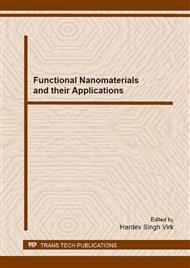[1]
M. A. M. Motchelaho, H. Xiong, M. Moyo, L. L. Jewella, N. J. Coville, Effect of acid treatment on the surface of multiwalled carbon nanotubes prepared from Fe–Co supported on CaCO3: Correlation with Fischer–Tropsch catalyst activity, J. Mol. Catal. A: Chem. 335 (2011) 189-198.
DOI: 10.1016/j.molcata.2010.11.033
Google Scholar
[2]
J. Tkac, J.W. Whittaker, T. Ruzgas, The use of single walled carbon nanotubes dispersed in a chitosan matrix for preparation of a galactose biosensor, Biosens. Bioelectron. 22 (2007) 1820–1824.
DOI: 10.1016/j.bios.2006.08.014
Google Scholar
[3]
Bachtold, P. Hadley, T. Nakanishi, C. Dekker, Logic Circuits with Carbon Nanotube Transistors, Science 294 (2001) 1317-1320.
DOI: 10.1126/science.1065824
Google Scholar
[4]
V. Derycke, R. Martel, J. Appenzeller, Ph. Avouris, Carbon Nanotube Inter- and Intramolecular Logic Gates, Nano Lett. 1 (2001) 453-456.
DOI: 10.1021/nl015606f
Google Scholar
[5]
W.Feng, A. Fujii, M. Ozaki, K. Yoshino, Perylene derivative sensitized multi-walled carbon nanotube thin film, Carbon 43 (2005) 2501–2507.
DOI: 10.1016/j.carbon.2005.05.014
Google Scholar
[6]
J. L. Zimmermen, R. K. Bradley, C. B. Huffman, R. H. Hange, J. L. Margrave, Gas-Phase Purification of Single-Wall Carbon Nanotubes, Chem. Mater. 12 (2000) 1361-1366.
DOI: 10.1021/cm990693m
Google Scholar
[7]
K. B. Shelimov, R. O. Esenaliev, A. G. Rinzler, C. B. Huffman, R. E. Smalley, Purification of single-wall carbon nanotubes by ultrasonically assisted filtration, Chem. Phys. Lett. 282 (1998) 429-434.
DOI: 10.1016/s0009-2614(97)01265-7
Google Scholar
[8]
B. Zhao, H.Hu, S. Nlyogi, M. E. Itkis, M. A. Hamon, P. Bhowmik, M. S. Meier, R. C. Haddon, Chromatographic purification and properties of soluble single-walled carbon nanotubes, J. Am. Chem. Soc. 123 (2001) 11673-11677.
DOI: 10.1021/ja010488j
Google Scholar
[9]
V. Geogakilas, D. Voulgaris, E. Vazquez, M. Prato, D. M. Guldi, A. Kukovecz, H. Kuzmany, Purification of hipco carbon nanotubes via organic functionalization, J. Am. Chem. Soc. 124 (2002) 14318-14319.
DOI: 10.1021/ja0260869
Google Scholar
[10]
L. Stobinski, B. Lesiak, L. Kover, J. Toth, S. Biniak, G. Trykowski, J. Judek, Multiwall carbon nanotubes purification and oxidation by nitric acid studied by the FTIR and electron spectroscopy methods, J. Alloys Compd. 501 (2010) 77-84.
DOI: 10.1016/j.jallcom.2010.04.032
Google Scholar
[11]
S. R. C. Vivekchand, A. Govindaraj, M. M. Seikh, C. N. R. Rao, New Method of Purification of Carbon Nanotubes Based on Hydrogen Treatment, J. Phys. Chem. B 108 (2004) 6935-6937.
DOI: 10.1021/jp048737o
Google Scholar
[12]
Y-Y Fan, A. Kaufmann, A. Mukasyan, A. Varma, Single- and multi-wall carbon nanotubes produced using the floating catalyst method: Synthesis, purification and hydrogen up-take, Carbon 44 (2006) 2160-2170.
DOI: 10.1016/j.carbon.2006.03.009
Google Scholar
[13]
R. Rastogi, R. Kaushal, S.K. Tripathi, A. L. Sharma, Inderpreet Kaur, L. M. Bharadwaj, Comparative study of carbon nanotube dispersion using surfactants; Journal of Colloid and Interface Science 328 (2008) 421–428.
DOI: 10.1016/j.jcis.2008.09.015
Google Scholar
[14]
Y. Feng, H. Zhang, Y. Hou, T. P. McNicholas, D. Yuan, S. Yang, L. Ding, W. Feng, J. Liu, Room Temperature Purification of Few-Walled Carbon Nanotubes with High Yield, ACS Nano 2 (2008) 1634-1638.
DOI: 10.1021/nn800388g
Google Scholar
[15]
M. C. Schabel, J. L. Martinus, Energetics of interplanar binding in graphite, Phys. Rev. B 46 (1992) 7185-7188.
DOI: 10.1103/physrevb.46.7185
Google Scholar
[16]
J. Logeswari, A. Pandurangan, D. Sangeetha, An Efficient Catalyst for the Large Scale Production of Multi-Walled Carbon Nanotubes, Ind. Eng. Chem. Res. 50 (2011) 13347-13354.
DOI: 10.1021/ie102525u
Google Scholar
[17]
R.Yudianti, L. Indrarti, H. Onggo; J. Appl. Sci. 17 (2010) 1978-1982.
Google Scholar
[18]
A. K. Mishra, S. Ramaprabhu, Carbon dioxide adsorption in graphene sheets, AIP Adv. 1 (2011) 032152-032158.
DOI: 10.1063/1.3638178
Google Scholar
[19]
A. C. Ferrari, Raman spectroscopy of graphene and graphite: Disorder, electron–phonon coupling, doping and nonadiabatic effects, Solid State Communications 143, (2007) 47-57.
DOI: 10.1016/j.ssc.2007.03.052
Google Scholar
[20]
X. Zhao and Y. Ando, Raman Spectra and X-Ray Diffraction Patterns of Carbon Nanotubes Prepared by Hydrogen Arc Discharge, J.Appl. Phys. 37, (1998) 4846-4849.
DOI: 10.1143/jjap.37.4846
Google Scholar
[21]
J. Maultzsch, S. Reich, C. Thomsen, S. Webster, R. Czerw, D. L. Carroll, S. M. C. Vieira, P. R. Birkett, C. A. Rego, Raman characterization of boron-doped multiwalled carbon nanotubes, Appl. Phys. Lett. 81 (2002) 2647–2649.
DOI: 10.1063/1.1512330
Google Scholar


